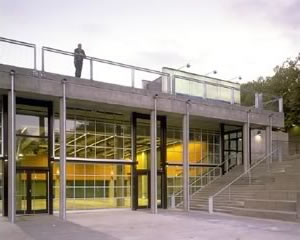

AIA/COTE Search for This
Year’s Top Ten Green Projects
Early submissions due February 23; final
submissions date is March 22
The AIA/COTE Top Ten Green Projects Web site, provided by the U.S. Department of Energy (DOE), is now open to accept entries. The AIA Committee on the Environment (COTE), in partnership with DOE, invites you to use the site to submit built projects electronically. Ten projects will be selected by jury as best-practice examples of a high-performance, sustainable design approach.
The Top Ten Green Projects program seeks to:
- Identify and recognize the benefits of a high-performance, sustainable design approach
- Educate the architecture community and the public at-large on the increased value that sustainable design provides for developers, building owners, and occupants
- Acknowledge architects as experts in the creation of energy-conscious and environmentally responsible design solutions.
 This
program, an international competition, welcomes submissions from all architects
licensed in the U.S. of projects located anywhere in the world. Projects
must have been completed after 1994 and may be large or small, new construction
or renovations, and any project type. Urban and regional design projects
are welcome.
This
program, an international competition, welcomes submissions from all architects
licensed in the U.S. of projects located anywhere in the world. Projects
must have been completed after 1994 and may be large or small, new construction
or renovations, and any project type. Urban and regional design projects
are welcome.
Top Ten’s top 10
In his welcome letter on the site, COTE Chair Mark Rylander, AIA, explains
that the Top Ten Program this year is “emphasizing design and community
integration while continuing to evaluate projects against a high standard
of energy performance.” The program also is working toward eventual
integration with DOE’s High Performance Buildings Database, and
the entry form includes a place for a U.S. Green Building Council’s
LEED™ rating system summary.
The Top Ten evaluation includes 10 top measures.
- Land Use describes the site and its context and measures the portion of land used for buildings and parking.
- Site Ecology describes how the design fits into the regional ecosystem and also measures the way storm water is managed.
- Community Design & Connection describes efforts to promote community and measures transportation strategies.
- Water Use describes how water is conserved and measures potable water use and wastewater reuse.
- Energy Performance describes and measures energy-efficiency strategies and performance.
- Energy Security highlights those issues that directly affect national energy independence, including renewable energy and the ability of buildings to function under emergency conditions.
- Materials & Construction describes approaches to materials in the design as well as strategies for recycling during construction and occupancy.
- Light & Air describes the approach to indoor environmental quality and measures to incorporate daylight and natural ventilation.
- Bio-Climatic Design describes how the design is appropriate to its region and climate.
 Long
Life, Loose Fit describes design flexibility for future reuse
of the building and design for disassembly.
Long
Life, Loose Fit describes design flexibility for future reuse
of the building and design for disassembly.
Entry requirements
Each project must be submitted electronically. An architect or firm may
submit more than one project, but each project must include a separate
registration form and fee, presentation board, and 8 to 10 illustrations
that best inform the jurors of the innovative sustainable design solution
that has been developed. Entrants must supply the single presentation
board by either the February 23 or March 22 deadline.
An invited jury will select the 2004 projects. Jury members will evaluate projects based on a broad and inclusive definition of design quality that includes performance, aesthetics, community connection, and stewardship of the natural environment. Each project will be evaluated on its own merit, rather than in competition with the other submittals. No prizes will be awarded. Winning projects will be recognized with an AIA/COTE award certificate and acknowledged in the national press, on the AIA Web site, and in a lecture presentation at the National Building Museum on May 27.
The 10 winning firms will be required to submit two sets of presentation boards, 24 x 24 x 1/2-inch. These must be received at the AIA by April 7. One set will be exhibited at the National Building Museum the evening of May 27, and the other will be exhibited at the 2004 AIA National Convention and Expo in Chicago, June 10–12. (Details on the board requirements will be sent to the winning firms when they receive notification of selection.)
Early submissions are due February 23 at 5 p.m. EST. The final submissions deadline is March 22 at 5:00 p.m. EST. For complete information, visit COTE’s Top Ten Web site.
Copyright 2004 The American Institute of Architects.
All rights reserved. Home Page ![]()
![]()
